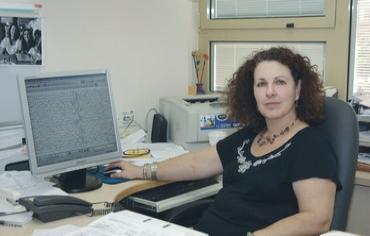Sheba-Weizmann-Duke collaboration focuses on mutation causing disease in children of Iranian and Bukharan origin.

Bruriya Ben Zee Photo: Courtesy Sheba Medical Center
Mutations in genes responsible for two serious neurological disorders in infants and children of Iranian and Bukharan origin that had not been described until now have been identified by researchers at Sheba Medical Center at Tel Hashomer, the Weizmann Institute of Science in Rehovot and Duke University in North Carolina.
Their work has just been published in the prestigious journals Neuron and the American Journal of Human Genetics.
The mutations were identified as part of research project to locate the genetic causes of some 100 serious diseases in the Israel population that have not been clear despite significant efforts to find the answers.
The work involved cooperation among Prof. Bruria Ben Zeev (head of the pediatric neurology unit at the Edmond and Lily Safra Children’s Hospital at Sheba; Prof. Yair Anikster (head of Safra’s metabolic disease unit); Prof. Alon Peres (head of Safra’s genetic institute); Prof. Doron Lancet (head of Weizmann’s Center for Genome Research); and Prof. David Goldstein (head of the Duke Center for Human Genome Variation).
Changes in the first gene causes a rare type of microcephaly (a small brain) in children of Iranian Jewish origin; they were under observation for years at Safra and at the neurology unit at Wolfson Medical Center in Holon.
The symptoms include having a head with a smaller-than-usual circumference at birth, slow growth of the head afterwards, severe mental retardation and convulsions.
The defect affects boys and girls equally and causes severe disability throughout their lives.
The researchers discovered that the gene is coded for the protein enzyme called asparagine synthetase (ASNS), which is responsible for the production of the amino acid called aspergine. This substance is one of 20 building blocks of all proteins and is provided in food, but because of the mutation, there is a major decline in its concentration in the brain. This harms brain development in the fetus at its early stages and causes accumulated damage after birth.
Even though it is a metabolic disease, the usual metabolic tests do not identify the defect because the measured levels of enzymes do not significantly vary from the normal range. Thus the new knowledge makes possible a specific genetic test for the defect.
The carrier rate among Jews of Iranian origin is high and reaches one per 60. Discovering the gene will make it possible to identify carriers of the disease before pregnancy, and the diagnosis of other patients. The researchers are looking into the possibility of developing treatment interventions for cases in which the mutation is not identified before birth.
The second mutation causing a genetic disease was found in children of Bukharan Jewish origin treated at Safra’s neurology unit. The carrier rate in this ethnic group is high – 1 per 40. This mutation causes severe retardation and muscle problem and often prevents children from walking independently.
Such children sometimes develop epilepsy and have respiratory troubles, especially during sleep, requiring respiration over night. The gene is called TECPR2 and involves the breakdown of various waste products in the body, including the brain. This process is called autophagy.
At present, there is no treatment, but the discovery will allow the identification of carriers and affected fetuses.
The cooperation between Israelis and researchers abroad makes it possible to prevent such severe genetic diseases from being handed down to offspring and will help find ways to treatment these and other disorders, the researchers said.
